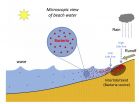New tool better protects beachgoers from harmful bacteria levels
Scientists offer more accurate health risk prediction model to better inform beach closure decisions
2015-06-10
(Press-News.org) MIAMI - An international team, led by researchers at the University of Miami (UM) Rosenstiel School of Marine and Atmospheric Science, has developed a new, timelier method to identify harmful bacteria levels on recreational beaches. The new model provides beach managers with a better prediction tool to identify when closures are required to protect beachgoers from harmful contaminates in the water.
"The development of this new model has allowed us, for the first time, to estimate contamination levels on beaches subject to nonpoint source pollution, in particular from beach sand and runoff from storms," said the study's authors.
The new method provides beach health managers with an easily accessible computer model to predict harmful bacteria levels from all potential pollution sources. The team optimized and validated their model using a 10-day monitoring dataset from the popular Virginia Beach in Miami, Florida. The predictive model uses information on waves, tides, rainfall and solar radiation to more accurately predict harmful bacteria concentration and movement along the shore allowing for improved beach management decision-making.
Federal and state laws require water monitoring of fecal indicator bacteria, such as enterococci and fecal coliform, at recreational beaches to protect beachgoers from harmful water contamination levels. Excess levels of these harmful bacteria prompt beach advisories and closures to minimize human health risks. Water contamination from fecal indicator bacteria can result from "point-source" pollution, such as a sewage outfall, or "nonpoint source" pollution from storm-water runoff, or animal and human inputs.
Current methods assess fecal bacteria contamination levels by direct sampling of water from beaches, as well as by using complex computer modeling. Direct sampling methods requires a one-day laboratory analysis to access the health risk to humans at a particular beach. Therefore, a 24 to 48 hours wait period after sampling is required before any beach closure or advisory is issued. In addition, the current computer-based model requires high computing power, which is often inaccessible to beach closure decision managers, and can only predict contaminates from known sources of pollution, such as sewage outfalls.
The National Science Foundation-funded study, titled "A predictive model for microbial counts on beaches where intertidal sand is a primary source," was published in the May 15 issue of the journal Marine Pollution Bulletin. The co-authors include: UM Rosenstiel School alumnus Zhixuan Feng of Woods Hole Oceanographic Institution; Ad Renier, Brian K. Haus, and John D. Wang of the UM Rosenstiel School of Marine and Atmospheric Science; Helena M. Solo-Gabriele of the UM School of Engineering; Lora E. Fleming of the university of Exeter Medical School. NSF Awards: OCE-0432368, OCE-0911373, OCE-1127813
INFORMATION:
About the University of Miami's Rosenstiel School
The University of Miami is one of the largest private research institutions in the southeastern United States. The University's mission is to provide quality education, attract and retain outstanding students, support the faculty and their research, and build an endowment for University initiatives. Founded in the 1940's, the Rosenstiel School of Marine & Atmospheric Science has grown into one of the world's premier marine and atmospheric research institutions. Offering dynamic interdisciplinary academics, the Rosenstiel School is dedicated to helping communities to better understand the planet, participating in the establishment of environmental policies, and aiding in the improvement of society and quality of life. For more information, visit: http://www.rsmas.miami.edu.
[Attachments] See images for this press release:

ELSE PRESS RELEASES FROM THIS DATE:
2015-06-10
Short boys are three times more likely than short girls to receive recombinant human growth hormone treatment for idiopathic short stature (ISS), even though in a general pediatric population, equal proportions of both genders fall under the height threshold designating ISS. Researchers who analyzed records of over 283,000 U.S. children and adolescents found a clear-cut and persistent gender bias in the provision of treatment.
"Growth is an important sign of child health, so growth failure merits equal consideration for both boys and girls," said study leader Adda Grimberg, ...
2015-06-10
DARIEN, IL - A new study suggest sleep problems and energy product use are associated with increased alcohol use in teens, even after controlling for sociodemographics and mental health.
Results show that both sleeping problems and use of energy products are associated with greater risk of alcohol use in teenagers, according to a study conducted by the RAND Corporation.
"Our findings suggest that teenagers may be using highly caffeinated energy products to cope with sleep loss, and both sleep problems and energy product use are associated with increased risk of alcohol ...
2015-06-10
INDIANAPOLIS -- The worldwide demand for legumes, one of the world's most important agricultural food crops, is growing; at the same time, their production has been adversely affected by drought. In an Indiana University-Purdue University Indianapolis research paper published today in the journal PLOS ONE, researchers provide information that could help agricultural planning and management to minimize drought-induced yield losses.
Legumes, which include peas, beans, peanuts and alfalfa, are grown in almost every climatic region and are second only to cereals in terms ...
2015-06-10
Plants can undergo the same extreme 'chromosome shattering' seen in some human cancers and developmental syndromes, UC Davis researchers have found. Chromosome shattering, or 'chromothripsis,' has until now only been seen in animal cells. A paper on the work is published in the online journal eLife.
The process could be applied in plant breeding as a way to create haploid plants with genetic material from only one parent, said Ek Han Tan, a postdoctoral researcher in the UC Davis Department of Plant Biology and first author on the paper. Although plants don't get cancer, ...
2015-06-10
The public can now make a more informed choice about long-term care thanks to a new online tool launched today that compares facilities across Canada based on nine indicators such as safety, quality of life and general health of residents.
Researchers at the University of Waterloo led the development of the assessment criteria and quality measures that will allow people to compare data of more than 1,000 facilities. They are members of interRAI, a global network developing assessment and screening tools to support vulnerable populations.
'This website provides Canadians ...
2015-06-10
A large data-mining study carried out by investigators at the Stanford University School of Medicine has linked a popular class of heartburn drugs to an elevated risk of heart attack.
Proton-pump inhibitors, or PPIs, are among the world's most widely prescribed drugs, with $14 billion in annual sales. They are effective at lowering the acidity of the stomach, in turn preventing heartburn, a burning sensation in the chest that occurs when stomach acid rises up into the esophagus. In any given year, more than 20 million Americans -- about one in every 14 -- use PPIs such ...
2015-06-10
Chimpanzee may be able to use facial expressions and vocalizations flexibly, notably during physical contact play, according to a study published June 10, 2015 in the open-access journal PLOS ONE by Marina Davila-Ross from University of Portsmouth, UK and colleagues.
The ability to flexibly produce facial expressions and vocalizations has a strong impact on the way humans communicate, but scientists' understanding of nonhuman primate facial expressions and vocalizations is limited. The authors of this study investigated whether chimpanzees produce the same types of ...
2015-06-10
People reflecting on a roundtrip walk estimated that the return trip took less time than the outward trip, according to a study published June 10, 2015 in the open-access journal PLOS ONE by Ryosuke Ozawa from Kyoto University, and colleagues.
Many have experienced the "return trip effect," where the return trip seems shorter than the outward trip, even when the trips actually took the same amount of time. Scientists have studied the effect, but haven't confirm its existence in the context of the environment and duration of the real-life trip. To better understand the ...
2015-06-10
This news release is available in French.
A study at the University of Montreal shows that the market share of the five largest research publishing houses reached 50% in 2006, rising, thanks to mergers and acquisitions, from 30% in 1996 and only 20% in 1973. "Overall, the major publishers control more than half of the market of scientific papers both in the natural and medical sciences and in the social sciences and humanities," said Professor Vincent Larivière of the School of Library and Information Science, who led the study. "Furthermore, these large commercial ...
2015-06-10
Most Americans are aware that food waste is a problem, are concerned about it, and say they work to reduce their own waste, but nearly three-quarters believe that they waste less food than the national average, new research suggests.
The findings, from the Johns Hopkins Center for a Livable Future (CLF) at the Johns Hopkins Bloomberg School of Public Health, are significant given that 31 to 40 percent of the American food supply goes to waste, primarily in homes, stores and restaurants. The top foods wasted, by weight, are fruits and vegetables, due in part to their perishability ...
LAST 30 PRESS RELEASES:
[Press-News.org] New tool better protects beachgoers from harmful bacteria levels
Scientists offer more accurate health risk prediction model to better inform beach closure decisions

